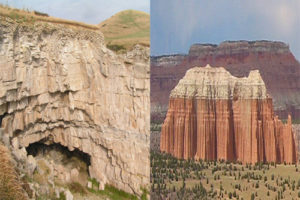Sandstone, a deposit of cementing material for building from rock grains come in different colors depending on the region where the material is found. The common colors include but not exclusive to tan, brown, yellow, red, gray and white. Sandstone contains calcium carbonate, iron oxides which vary in solidity to form the cement material. Three elements establish the composition of sandstones.
- Quartz grains
- Feldspar grains
- Rock fragment grains
The ratio of these three ingredients in the composition of the final sandstone determines the various colors and physical features of the final product.
Sandstones are mainly used for “paving, roofing, flooring, making beams, pillars, doors and window sills, wall facing, fence posts,” due to its resistance to exterior exposure to weather conditions.
Limestone
Limestone is formed from fossils in lakes and seabed. Over long period of time, layers of hardened organic matter is built up and solidified through chemical reaction at the bottom of water to make solid limestone. This material containing 95% of calcium carbonate is good for polishing and is used for decoration in buildings.
Sandstone is used in metallic road construction owing to its hardness. Limestone is vulnerable to rain water which limits its usage in comparison to sandstones.



